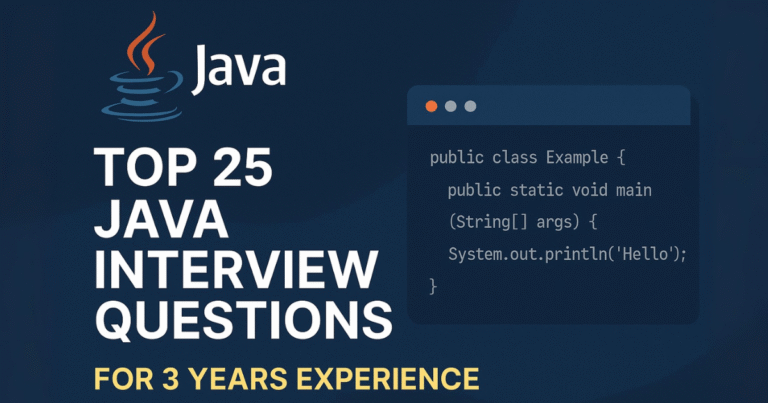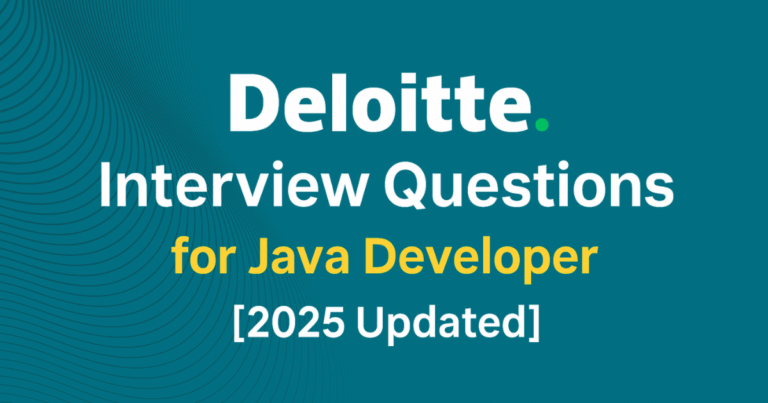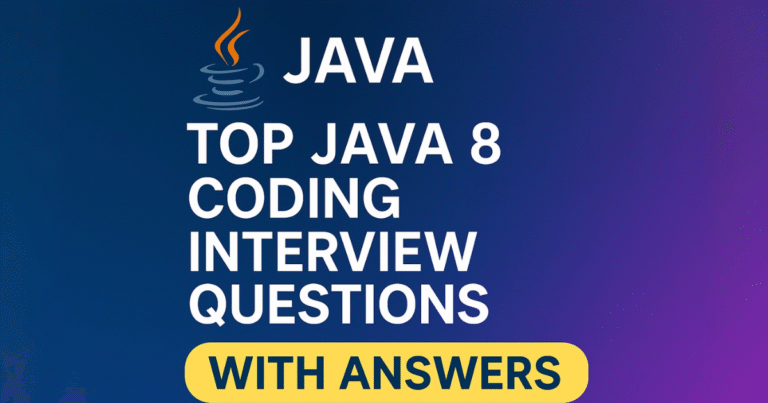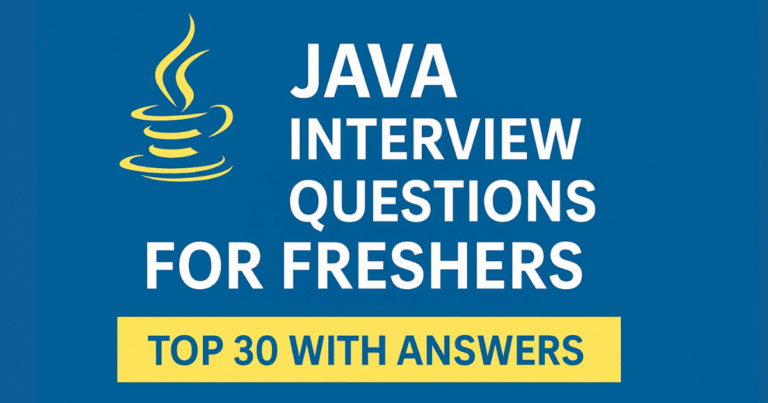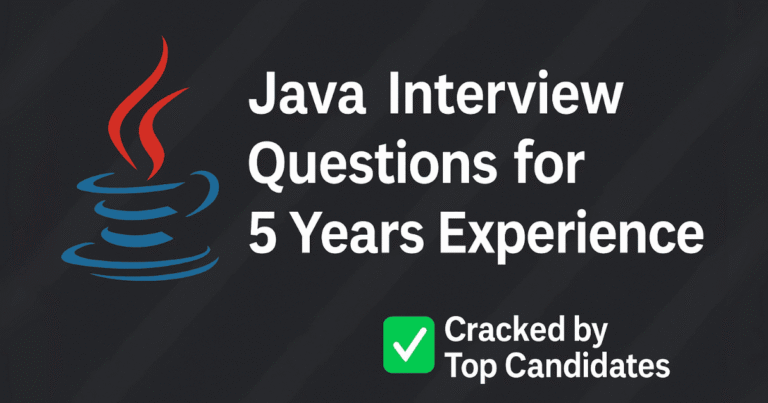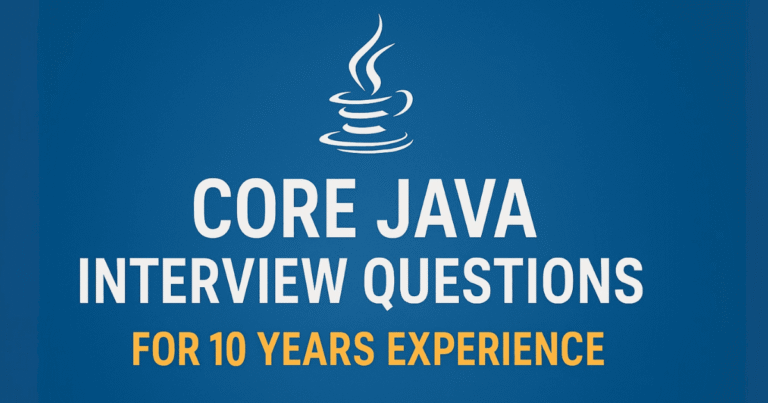Top 35 Java Interview Questions for 10 Years Experience (2025 Update)
If you’re preparing for senior Java interviews, you’re expected to go beyond syntax and prove your understanding of architecture, performance, scalability, design patterns, and real-world coding practices. Here are 35 advanced Java interview questions (with answers).
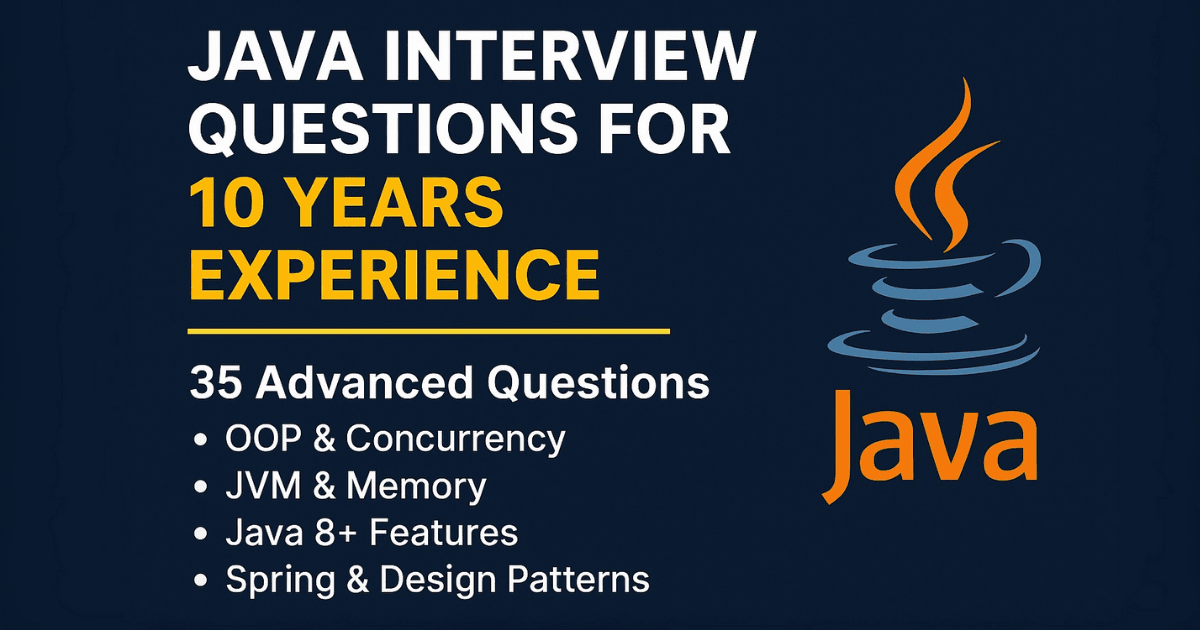
🔹 Core Java & OOPs (Senior-Level)
1. Explain SOLID principles in Java.
Answer:
- S: Single Responsibility Principle
- O: Open/Closed Principle
- L: Liskov Substitution Principle
- I: Interface Segregation Principle
- D: Dependency Inversion Principle
These improve code maintainability and extensibility.
2. What is the difference between composition and inheritance?
Answer:
- Inheritance: “is-a” relationship
- Composition: “has-a” relationship
Prefer composition over inheritance for flexibility and testability.
3. What are design patterns used in Java?
- Singleton
- Factory
- Strategy
- Observer
- Builder
- Adapter
- Proxy
- MVC
4. How is memory managed in Java?
Memory is managed by the JVM via:
- Heap & Stack
- Garbage Collector (GC)
- Minor/Major GC
- GC Algorithms (G1, CMS, ZGC)
5. What is the difference between HashMap and ConcurrentHashMap?
| Feature | HashMap | ConcurrentHashMap |
|---|---|---|
| Thread-safe? | No | Yes |
| Performance | High (single-threaded) | Good (multi-threaded) |
| Allows null key? | One null key | No null keys |
6. What is the use of volatile keyword?
Volatile ensures visibility of changes to variables across threads. It prevents caching of the variable.
7. Explain the Java Memory Model (JMM).
It defines how threads interact through memory and how variables are read/written in concurrent scenarios.
8. What is the difference between Callable and Runnable?
Runnable→ returns void, can’t throw checked exceptionsCallable→ returns a value, can throw checked exceptions
9. How do you detect and avoid memory leaks?
- Use profilers (JVisualVM, YourKit, etc.)
- Release references
- Avoid static context for heavy objects
- Use WeakReferences/SoftReferences when needed
10. What is double-checked locking?
It’s a technique to reduce overhead of acquiring a lock by checking condition before and after synchronization.
🔹 Multithreading & Concurrency
11. What is ThreadPoolExecutor? How do you configure it?
It’s a flexible way to create thread pools:
ExecutorService executor = new ThreadPoolExecutor(
2, 4, 60, TimeUnit.SECONDS, new LinkedBlockingQueue<Runnable>());
12. Explain difference between synchronized block and lock API.
synchronizedis implicit and less flexibleReentrantLockis explicit and provides more control (timeouts, tryLock)
13. What is Future and CompletableFuture?
Futureis blockingCompletableFuturesupports async, chaining, and better concurrency control (introduced in Java 8)
14. How do you prevent deadlock in Java?
- Acquire locks in a consistent order
- Use timeout-based locking
- Try using higher-level concurrency utilities
15. Difference between wait(), sleep(), and yield()
sleep()→ pauses thread for fixed timewait()→ pauses until notify/notifyAll is calledyield()→ hints scheduler to give chance to other threads
🔹 Java 8+ Features (Must Know for Senior Roles)
16. How do you use Stream API effectively?
Example:
List<String> names = list.stream()
.filter(name -> name.startsWith("A"))
.map(String::toUpperCase)
.collect(Collectors.toList());
17. What is Optional in Java 8?
A container object that may or may not contain a non-null value. Helps avoid NullPointerException.
18. How does method reference work?
list.forEach(System.out::println);
This is a shorthand for lambda expressions.
19. How are default methods in interfaces useful?
They allow adding new methods to interfaces without breaking existing implementations.
20. Difference between flatMap and map?
map()transforms dataflatMap()flattens nested structure
🔹 Java Collections & Performance
21. What is the internal structure of HashMap?
- Bucket-based using hashCode
- Collisions handled via chaining (LinkedList or TreeNode after Java 8)
22. How do you improve performance in large-scale Java apps?
- Use caching (e.g., Caffeine, Redis)
- Use object pooling
- Optimize GC settings
- Profile I/O and thread bottlenecks
- Use parallel streams only when needed
23. What is LinkedHashMap? How does it maintain order?
It maintains insertion order or access order via a doubly-linked list.
24. How does ConcurrentHashMap avoid locking the whole map?
It uses bucket-level locking (segment-based in Java 7, node-based in Java 8+).
25. Difference between fail-fast and fail-safe iterators?
- Fail-fast → throws
ConcurrentModificationException - Fail-safe → works on a clone (e.g.,
CopyOnWriteArrayList)
🔹 Spring & Architecture
26. What are common Spring Boot annotations?
@SpringBootApplication@RestController@Service,@Repository,@Component@Autowired@Value,@Configuration,@Bean
27. Explain Dependency Injection (DI) vs Inversion of Control (IoC)
- IoC is the principle, DI is the implementation.
- DI lets Spring inject dependencies instead of the class creating them itself.
28. How do you handle exceptions in Spring REST API?
- Use
@ControllerAdvicewith@ExceptionHandler - Return standardized error response using
ResponseEntity
29. How do you secure a Spring Boot application?
- Spring Security
- OAuth2 / JWT
- CSRF protection
- Role-based access control (RBAC)
30. What is circuit breaker in microservices?
A pattern to gracefully degrade service when dependent services are failing. Tools: Resilience4j, Hystrix.
🔹 Advanced & System Design
31. How would you design a scalable RESTful API?
- Stateless services
- Pagination, caching, rate limiting
- DTOs, input validation
- Swagger/OpenAPI
- Async processing (Kafka, RabbitMQ)
32. What are some common Java-based messaging solutions?
- Apache Kafka
- RabbitMQ
- ActiveMQ
- Amazon SQS
33. Explain CAP theorem. Where does Java fit?
CAP = Consistency, Availability, Partition Tolerance
In distributed systems, you can only guarantee 2 out of 3.
Java frameworks like Spring Cloud, Hazelcast, or Apache Ignite manage this.
34. How do you write unit & integration tests in Java?
- Unit: JUnit 5 + Mockito
- Integration: Spring Boot Test + @DataJpaTest / @WebMvcTest
- Use TestContainers for real DB testing
35. What is your approach to code review in a senior role?
- Check for SOLID principles
- Verify business logic correctness
- Look for performance issues
- Ensure readability and maintainability
- Adhere to coding standards & error handling
✅ Final Tips for 10-Year Java Interviews
- Be ready with 1–2 system design problems
- Have real project examples to back your answers
- Know JVM internals and memory tuning
- Be confident with Spring, Java 8+, and clean architecture
✅ FAQ
What are the most asked Java interview questions for 10 years experience?
Questions usually revolve around multithreading, concurrency, design patterns, JVM internals, Spring Boot, REST API security, and system design.
What topics should I prepare for a senior Java developer interview?
Focus on SOLID principles, memory management, concurrency, Spring Boot architecture, design patterns, microservices, and performance optimisation.
How to answer system design questions in Java interviews?
Use concepts like scalability, load balancing, REST principles, caching, database optimization, and explain the architecture using real-world use cases
Is Java still relevant for senior developers in 2025?
Yes, Java is still widely used in large-scale enterprise apps, Spring-based microservices, backend systems, fintech, and Android development.
What are the best resources to prepare for 10 years Java interview?
You should practice coding on LeetCode, system design on GitHub/Grokking, review Spring documentation, and revise Java 8+ features deeply.
official Java documentation
Link: https://docs.oracle.com/en/java/


